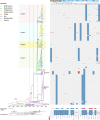The Asian Lineage of Zika Virus: Transmission and Evolution in Asia and the Americas
- PMID: 30684211
- PMCID: PMC6420435
- DOI: 10.1007/s12250-018-0078-2
The Asian Lineage of Zika Virus: Transmission and Evolution in Asia and the Americas
Abstract
Since first isolation in 1947 from the Zika forest in Uganda, Zika virus (ZIKV) has been principally known as a benign agent associated with sporadic human infections in a restricted number of African countries. However, during 2015-2016, an Asian lineage of ZIKV caused an unprecedentedly large outbreak in the Americas and sizeable numbers of exported cases across the globe. In this review, we critically appraise the recent advances in molecular epidemiological studies of ZIKV performed to date, and we highlight the pivotal role played by genomic surveillance in elucidating the origins, dissemination and evolution of the Asian lineage of ZIKV in Asia and in the Americas.
Keywords: Asian lineage; Evolution; R e; Transmission; Zika virus (ZIKV).
Conflict of interest statement
The authors declare that they have no conflict of interest.
The authors declare that they have no conflict of interest. This article does not contain any studies with human or animal subjects performed by any of the authors.
Figures


References
-
- Bayer A, Lennemann NJ, Ouyang Y, Bramley JC, Morosky S, Marques ET, Jr, Cherry S, Sadovsky Y, Coyne CB. Type iii interferons produced by human placental trophoblasts confer protection against zika virus infection. Cell Host Microbe. 2016;19:705–712. doi: 10.1016/j.chom.2016.03.008. - DOI - PMC - PubMed
-
- Besnard M, Eyrolle-Guignot D, Guillemette-Artur P, Lastere S, Bost-Bezeaud F, Marcelis L, Abadie V, Garel C, Moutard ML, Jouannic JM, Rozenberg F, Leparc-Goffart I, Mallet HP. Congenital cerebral malformations and dysfunction in fetuses and newborns following the 2013 to 2014 zika virus epidemic in french polynesia. Euro Surveill. 2016;21:30181. doi: 10.2807/1560-7917.ES.2016.21.13.30181. - DOI - PubMed
Publication types
MeSH terms
LinkOut - more resources
Full Text Sources
Medical

